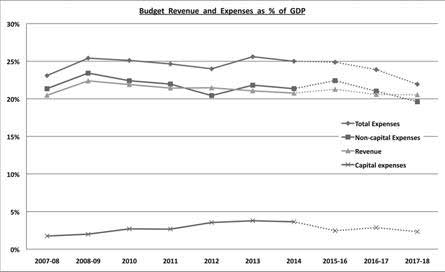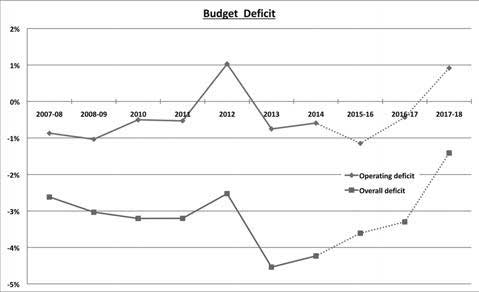Publicité
Budget – A leap of faith
Par
Partager cet article
Budget – A leap of faith

The main fiscal challenge of the 2015-16 budget is to cope with soaring expenses stemming from an increase in basic retirement pensions, and in employee compensation. Basic retirement and related pensions increase by 31% between 2014 and 2015-16, or an extra bill of close to Rs 4 bn, representing a quarter of the budget deficit. Employee compensation is also rising by some Rs 3 bn, on account of a generous pay increase above the inflation rate.
The standard policy options to cope with fiscal threats are to raise revenues, cut spending, or let the deficit run wild. A proper mix between these choices, in conjunction with sectoral reforms, will best ensure the realization of key macroeconomic goals, such as growth and stability.
First, by containing the overall budget deficit to a prudent level for ensuring long-term debt sustainability, and secondly by restraining the operating balance between non-capital expenditure and revenue to provide the maximum fiscal space for public investments, which are essential for boosting growth and employment.
The 2015-16 budget does not stand up well on both these counts, with relatively high overall and operating budget deficits, giving rise to concerns that the new fiscal orientation, if pursued, could take the country on a risky path. The budgetary projections for the following years do imply a substantial fiscal correction by 2017-18, but this future adjustment scenario is more seductive than persuasive.
MACROECONOMIC ISSUES
In the current context, the economy faces two potential dangers to macroeconomic stability, namely, the mounting public debt burden, and the gaping external current account deficit. The level of public sector debt has already crossed the critical threshold of 60% of GDP, and is at “an alarming level”, according to the budget. And the current account of the balance of payments has recorded high deficits of the order of 10% of GDP, which “cannot be sustained as they will undermine macroeconomic fundamentals”, as also noted in the budget.
While the spurt in capital spending in recent years has bolstered growth, it was not adequately financed through higher taxation. Consequently, the budget deficit (as derived by the IMF) surged to high levels of over 4% of GDP both in 2013 and 2014, leading to a rising public debt ratio.
The sizeable current account deficit is a reflection of fundamental economic imbalances. The savings rate is depressed to record low levels, and is even threatening to turn into a single digit. We should be saving more and consuming less of our income, including on imports. The export of goods and services, relative to the GDP, has steadily declined from over 60% in the 1990s, and is currently stagnating at around 55%. Investments and production should be geared more towards exports, especially of services.
The continued financing of the current account deficit by capital flows relating chiefly to the transit of investments into India is a source of vulnerability to the mauritian economy. To reduce the risks posed by a large current account deficit, export competitiveness can also be enhanced through productivity gains, or through the elimination of any exchange rate overvaluation.
The budget does not provide a convincing response to deal with these twin macroeconomic issues. The outlook on public indebtedness still poses risks on account of the relatively high fiscal deficit, and it is not clear how monetary and fiscal policies are reinforcing savings, exports and export competitiveness. The fillip to private investments, without a change in policies, will in fact worsen the current account deficit, adding to the economy’s vulnerabilities.
BUDGETARY OUTCOMES
A closer look at budgetary outcomes will help to elaborate further. To curtail the adverse impact of social spending on the budget for 2015-16, capital spending has been slashed and revenue hiked by a stealth tax on petroleum products and income of the State Trading Corporation (STC).
Capital spending, or the net acquisition of financial assets, including expenditure from the special funds, will be reduced by 24% between 2014 and 2015-16, falling from 3.6% to a meagre of 2.5% of GDP, and further down to 2.3% in 2017-18. Clearly, capital spending is bearing the burden for greater social spending.
A significant revenue effort of Rs 2.7 bn has been made for fiscal 2015-16, though a levy of Rs 1.3 bn on petroleum products, and by also tapping the STCs’ surplus income, to the extent of Rs1.4 bn. The dismantling of the automatic price adjustment mechanism has not allowed consumers to benefit fully from the global decline in oil prices, providing a windfall income to the STC. Total revenue, also buoyed by optimistic growth assumptions, is thus estimated to rise by 15% in 2015-16, compared to 2014.
Despite these adjustment measures, the overall deficit (as defined by the IMF, including special funds) remains at a relatively high level of 3.6% of GDP in 2015-16. But, compared to 4.2% in 2014, the deficit is sufficiently reduced to permit a relative stabilization of public debt. In the intervening first half of 2015, the deficit reaches as high as 4.6% of GDP, including net capital spending of Rs 2 bn from the special funds.

Stronger adjustment is however projected in the ensuing years, to bring down the overall deficit to 1.4% of GDP in 2017-18, mainly by compressing non-capital expenses to grow by only about 2.5% each year, compared to 18% in 2015-16. The operating deficit, which almost doubled to 1.1% of GDP in 2015-16, is projected to reverse to a surplus of 0.9% in 2017-18. A fiscal effort of about 2% of GDP over the next two years would indeed represent a tremendous achievement in restoring financial soundness and stability.
Unfortunately, these over-optimistic projections seem to have been drawn from the back of an envelope. Employee compensation is thus projected to increase by only 4.1% in 2016-17 and 2.5% in 2017-18, compared to 12% in 2015-16. Such a limited increase despite another expected PRB award will be a remarkable feat. A postponement of the PRB exercise might well be on the cards. Subsidies on the purchase of goods and services will all be frozen, while social benefits increase by only 3.5 % in 2017-18. Reservations aside, it would be salutary to witness the successful implementation of this harsh but necessary fiscal scenario. Present gains should, as sure as night follows day, entail future pains.
PRIVATE INVESTMENTS
The 2015-16 budget maintains a broadly expansionary stance to sustain overall consumption and growth. But, owing to the restraint on public investments, the scope for generating higher growth and employment is narrowed. Whether under compulsion or by pragmatic choice, the budget has therefore adopted a strategy to extend uninhibited support to the private sector to drive investments and growth, through the development of SMEs and the pursuit of ambitious real estate and related projects, packaged as smart cities and technopoles.
The domestic investment rate is thus projected to jump from 19.4% of GDP in 2014 to 24.8% in 2015-16, while GDP itself is to increase significantly from 3.5% to 5.3%. It is is not an impossible task, but success in the short-term is far from certain. To recall, the past burst in construction activity from IRS/ RES developments was relatively short-lived, and this sector remains vulnerable to the vagaries of the global economy. Moreover, there are many lessons to be learnt from the demise of MCCB 1 and 2, the dismal state of the DBM, and the experience of other state owned financial institutions that have failed to cater to the adequate financing of SMEs.

SMEs and productive private investments, that do more than unlock land values, deserve every support and will lead to sustainably higher growth in the longer term. Whatever the scepticism regarding the optimistic growth forecasts, Government’s renewed and forceful commitment to facilitate and bolster private investments will undoubtedly reinvigorate the economy.
These private investments should be geared more to production for export, particularly of services, instead of a focus on real estate driven activities. Without a renewed savings effort and an export re-orientation, an investment boom will aggravate external imbalances. The exchange rate can help in raising export competitiveness, but, with slack global demand and the weakness in competitors’ currencies as well, it would not be advisable to put too much store in the value of the rupee. More actions should be devoted to raising productivity, improving the functioning of the labor market, and strengthening the work ethic.
WELFARE REFORMS
A natural victim of social spending, capital spending will require strong expansion to meet the country’s substantial infrastructure needs, in water, transport, energy, communications, among other sectors, to reach at least 3.5% of GDP.
In its projections for the coming years, the budget recognizes that the fiscal distortions caused by the current hike in social spending will be reversed in future. The pain of fiscal adjustment is this being postponed to future years, in theory at least. Yet, an overhaul of the welfare state will become increasingly unavoidable to put public finances on a more sustainable course.
The pressures, especially from an ageing population, are growing. The recent steep increase in basic retirement pensions is a pointer to the broader underlying issues of adequacy of pension benefits, and the sustainability of the pension system. While some positive steps have already been taken to introduce a contributory pension scheme in the civil service and to extend the retirement age, a whole gamut of measures will have to be further envisaged.
Deep reforms in pensions, health and education, are essential to raise the quality and delivery of these public services by strengthening their financial viability. A targeting of social benefits, higher pension contribution rates, pensions coverage for the self-employed, a national health insurance scheme, and the application of means testing in the delivery of public services, are among some of the inevitable reform measures.
With rising dependency ratios, it is unfair to impose on the younger generation the rising pension and health costs of population ageing, and even more unjust to equip them with inadequate learning and job skills. The association between poor educational performance, unemployment and poverty provides hope for an effective and lasting solution to the eradication of remaining pockets of poverty.
CONCLUSION
Our fiscal strategy should be adequately strengthened to address major macroeconomic risks. For sound economic governance, the budget should consolidate taxation and review its high dependence on tax buoyancy to meet both social and infrastructure spending, restore the growth-enhancing role of public investments along with private investments, including through joint ventures, and engage in bold reforms to enhance the effectiveness and delivery of public services.
Publicité
Publicité
Les plus récents






